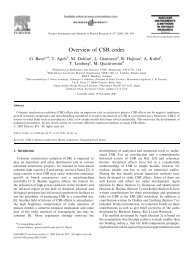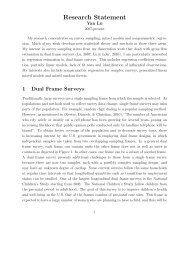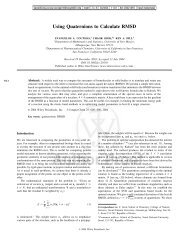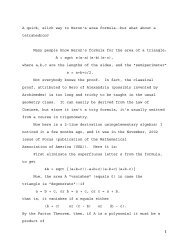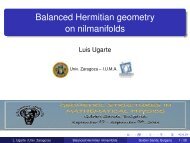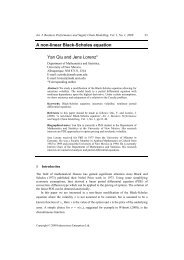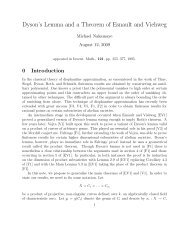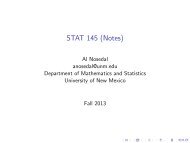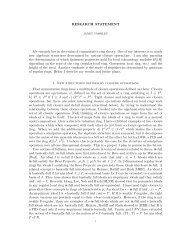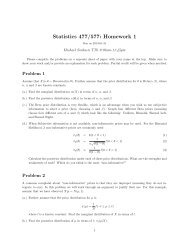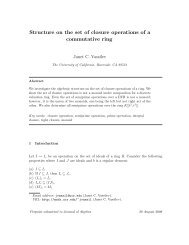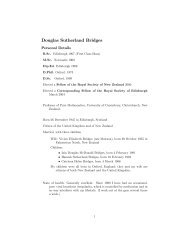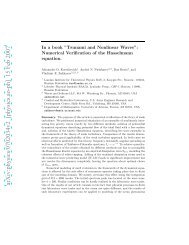OEO Office of Equal Opportunity - Department of Mathematics and ...
OEO Office of Equal Opportunity - Department of Mathematics and ...
OEO Office of Equal Opportunity - Department of Mathematics and ...
Create successful ePaper yourself
Turn your PDF publications into a flip-book with our unique Google optimized e-Paper software.
240 ARTS AND SCIENCES<br />
446./546. Introduction to Language Change. (3) Bybee,<br />
Cr<strong>of</strong>t<br />
(Also <strong>of</strong>fered as ANTH 416.) Theories <strong>and</strong> methods <strong>of</strong> comparative<br />
<strong>and</strong> historical linguistics, emphasizing change in<br />
English, Indo-European <strong>and</strong> Native American languages.<br />
Prerequisite: 304.<br />
447./547. Old English. (3 to a maximum <strong>of</strong> 6) ∆<br />
(Also <strong>of</strong>fered as ENGL 447./547.) An introduction to the<br />
grammar, syntax, <strong>and</strong> phonology <strong>of</strong> Old English. Prepares<br />
students for more advanced studies in this <strong>and</strong> later periods.<br />
449./549. Middle English Language. (3)<br />
(Also <strong>of</strong>fered as ENGL 449./549.) Comprehensive study<br />
<strong>of</strong> Middle English dialects <strong>and</strong> the development <strong>of</strong> Middle<br />
English from Old English. Prepares students for Middle<br />
English literature.<br />
460./560. Child Language. (3) John-Steiner, Morford<br />
(Also <strong>of</strong>fered as PSY 422.) Theories, methodologies <strong>and</strong><br />
findings in child language from birth to late childhood.<br />
Emphasizes implications <strong>of</strong> child language data for linguistic<br />
<strong>and</strong> psycholinguistic theories. Topics: biological foundations;<br />
pre-linguistic communication; phonological, syntactic, semantic<br />
<strong>and</strong> pragmatic development; bilingualism.<br />
Prerequisite: LING/PSY 367.<br />
469L./569L. Experimental Psycholinguistics. (3) Morford<br />
(Also <strong>of</strong>fered as PSY 469L.) Laboratory course in psycholinguistics;<br />
review <strong>of</strong> classic issues <strong>and</strong> research. Provides an<br />
opportunity to learn basic research methods in experimental<br />
psycholinguistics <strong>and</strong> gain skills necessary to conduct independent<br />
research.<br />
Prerequisites: 367 or PSY 367.<br />
490./590. Topics in Linguistics. (1-3 to a maximum <strong>of</strong><br />
12) ∆<br />
Special topics motivated by expertise <strong>of</strong> instructor <strong>and</strong> interest<br />
<strong>of</strong> students.<br />
495. Undergraduate Problems. (1-6) ∆<br />
For original individual study project approved by instructor.<br />
Maximum <strong>of</strong> 6 hrs. creditable to linguistics major or minor.<br />
Restriction: permission <strong>of</strong> instructor.<br />
498. Reading <strong>and</strong> Research for Honors. (3)<br />
Restriction: permission <strong>of</strong> instructor.<br />
499. Honors Thesis. (3)<br />
Prerequisite: 498.<br />
502. Generative Theories <strong>of</strong> Phonology. (3) Bybee,<br />
Smith<br />
The basic organizational units <strong>of</strong> phonology: features, segments,<br />
syllables, words, suprasegmentals, tone, stress <strong>and</strong><br />
intonation. Topics: natural phonological processes, diachronic<br />
changes, <strong>and</strong> typological variation involving these units.<br />
Prerequisite: 304 or 504 or SPAN 545.<br />
503. Usage-based Phonology. (3) Bybee, Smith<br />
The nature <strong>of</strong> phonological representations in the lexicon<br />
<strong>and</strong> the interaction <strong>of</strong> morphology, syntax, <strong>and</strong> language use<br />
with phonology. Topics: underspecification, lexical phonology,<br />
cognitive phonology, rules, schemas, <strong>and</strong> productivity.<br />
Prerequisite: 304 or 504 or SPAN 545.<br />
504./304. Phonological Analysis. (3) Smith<br />
(Also <strong>of</strong>fered as ANTH 517.) Phonetic principles <strong>and</strong> phonological<br />
theory, descriptive analysis <strong>of</strong> phonological systems,<br />
transcriptional practice, <strong>and</strong> problems from selected<br />
languages.<br />
Prerequisite: 303 or SPAN 350.<br />
505. Survey <strong>of</strong> Phonetic Theory. (3) Smith<br />
Advanced topics in phonetics. Acoustic <strong>and</strong> articulatory study<br />
<strong>of</strong> sounds in different languages; phonetic universals; models<br />
<strong>of</strong> speech production <strong>and</strong> perception; prosody; relation<br />
between phonetics <strong>and</strong> phonology.<br />
Prerequisites: 304 or 504 or SPAN 545.<br />
506./406. Introduction to Experimental Phonetics. (3) Smith<br />
Introduction to experimental methods used in the study <strong>of</strong><br />
speech. Laboratory exercises in computer-based measurement<br />
<strong>of</strong> acoustic <strong>and</strong> aerodynamic data. Acoustic theory<br />
illustrated by sounds in diverse languages. Introduction to<br />
speech technology.<br />
Prerequisite: 303 or SPAN 350.<br />
512./412. Morphology. (3) Axelrod, Bybee<br />
An introduction to principles underlying structure <strong>of</strong> words<br />
<strong>and</strong> paradigms in languages <strong>of</strong> different types. How word<br />
structure reflects cognitive organization <strong>and</strong> how it is affected<br />
by child language acquisition <strong>and</strong> historical change.<br />
Prerequisite: 322 or 522 or SPAN 351.<br />
513./413. Linguistic Field Methods. (3) Axelrod, Gorbet<br />
(Also <strong>of</strong>fered as ANTH 512) Practice in transcribing from<br />
oral dictation, phonemic analysis, introduction to problems<br />
<strong>of</strong> morphology.<br />
Prerequisites: (304 or 504 or SPAN 350) <strong>and</strong> (322 or 522).<br />
{Offered upon dem<strong>and</strong>}<br />
515./415. Native American Languages. (3) Axelrod<br />
(Also <strong>of</strong>fered as ANTH 515.) Survey <strong>of</strong> Indian languages <strong>of</strong><br />
North America, with special emphasis on languages <strong>of</strong> New<br />
Mexico. Particular languages <strong>and</strong> such issues as classification;<br />
language structure; relationship <strong>of</strong> languages <strong>and</strong> cultures;<br />
<strong>and</strong> language loss, maintenance <strong>and</strong> preservation.<br />
521. Formal Syntactic Theories. (3) Axelrod, Cr<strong>of</strong>t<br />
The study <strong>of</strong> universals <strong>of</strong> syntax from a generative or formal<br />
perspective. Description <strong>of</strong> cross-linguistic phenomena in at<br />
least two formal theories, such as Government <strong>and</strong> Binding,<br />
Generalized Phrase Structure Grammar or Lexical Functional<br />
Grammar.<br />
Prerequisite: 322 or 522.<br />
522./322. Grammatical Analysis. (3) Axelrod, Gorbet<br />
Principles <strong>of</strong> morphological <strong>and</strong> syntactic analysis <strong>and</strong><br />
introduction to functional <strong>and</strong> formal theories <strong>of</strong> grammar.<br />
Descriptive analysis <strong>of</strong> grammatical structures <strong>and</strong> problems<br />
from a variety <strong>of</strong> languages.<br />
Prerequisite: 292 or SIGN 305 or SPAN 351.<br />
523. Functional Syntactic Theories. (3) Axelrod, Cr<strong>of</strong>t,<br />
Travis, S. Wilcox<br />
(Also <strong>of</strong>fered as ANTH 513.) Description <strong>and</strong> explanation <strong>of</strong><br />
morphological, syntactic, <strong>and</strong> discourse phenomena, both<br />
in language-specific <strong>and</strong> typological perspective, in terms <strong>of</strong><br />
their cognitive representations <strong>and</strong> the cognitive <strong>and</strong> interactional<br />
processes in which they function.<br />
Prerequisite: 322 or 522 or SPAN 351.<br />
525./425. Semantic Analysis. (3) Axelrod, Cr<strong>of</strong>t, Travis<br />
An introduction to the study <strong>of</strong> sentence <strong>and</strong> word level<br />
meaning in the languages <strong>of</strong> the world, emphasizing the role<br />
<strong>of</strong> speaker <strong>and</strong> hearer, linguistic <strong>and</strong> extralinguistic context,<br />
lexical semantics, <strong>and</strong> grammatical meaning.<br />
Prerequisite: 292 or SIGN 305 or SPAN 351.<br />
529./429. Discourse Analysis. (3) Axelrod, Travis<br />
Introduction to the relationship <strong>of</strong> morphosyntax to the<br />
structure <strong>of</strong> discourse in the languages <strong>of</strong> the world. Topics:<br />
method <strong>and</strong> theory in the analysis <strong>of</strong> spoken <strong>and</strong> written discourse;<br />
basic notions such as topic, focus <strong>and</strong> cohesion.<br />
Prerequisite: 322 or 522 or SPAN 351.<br />
531./331. Language in Society. (3) Axelrod<br />
Introduction to sociolinguistics. Topics: social dialects, societal<br />
multilingualism, language contact, language attitudes,<br />
language policy <strong>and</strong> planning, the role <strong>of</strong> language in binding<br />
<strong>and</strong> defining communities.<br />
Prerequisite: 101 or 292 or 440.<br />
532./432. Spanish-English Bilingualism. (3)<br />
(Also <strong>of</strong>fered as LLSS 545.) An introduction to issues in<br />
bilingualism with emphasis on Spanish <strong>and</strong> English in the<br />
Southwest. Topics: language maintenance <strong>and</strong> shift, language<br />
policy <strong>and</strong> education, borrowing <strong>and</strong> codeswitching,<br />
first <strong>and</strong> second language acquisition, language attitudes.<br />
UNM CATALOG 2006–2007 Symbols, page 611.



